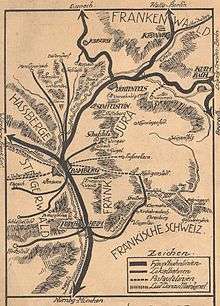Bad Staffelstein
| Bad Staffelstein | ||
|---|---|---|
| ||
 Bad Staffelstein | ||
Location of Bad Staffelstein within Lichtenfels district  | ||
| Coordinates: 50°06′N 10°58′E / 50.100°N 10.967°ECoordinates: 50°06′N 10°58′E / 50.100°N 10.967°E | ||
| Country | Germany | |
| State | Bavaria | |
| Admin. region | Oberfranken | |
| District | Lichtenfels | |
| Government | ||
| • Mayor | Jürgen Kohmann (CSU) | |
| Area | ||
| • Total | 99.39 km2 (38.37 sq mi) | |
| Population (2015-12-31)[1] | ||
| • Total | 10,231 | |
| • Density | 100/km2 (270/sq mi) | |
| Time zone | CET/CEST (UTC+1/+2) | |
| Postal codes | 96231 | |
| Dialling codes | 09573 | |
| Vehicle registration | LIF | |
| Website | www.bad-staffelstein.de | |

Bad Staffelstein is a small town in the Bavarian Administrative Region of Upper Franconia in Germany. It is known for the beautiful landscape that surrounds it, which has been given the name "Gottesgarten am Obermain" (Eden on the Upper Main). It contains many landmarks, such as the Basilica of the Vierzehnheiligen designed by Balthasar Neumann, the former monastery of Banz Abbey, now Banz Castle, and the 540 meter high Staffelberg. Most recently, it has been the thermal salt water spa, for which the town received the title "Bad" in 2001, that has made Staffelstein a tourist attraction.
Municipal Arrangement
Bad Staffelstein consists of the following boroughs:
|
|
History
Staffelstein was first mentioned around 800 and received its town status in 1130.
In 1846, with the construction of the Ludwig South-North Railway, the town was connected to the Bavarian rail network.
Boroughs
Kaider
Kaider is known for its stone industry, as well as for St. Mary's Chapel, which - prominently situated on a hill - can be easily seen from the state highway that runs from Bad Staffelstein to Wattendorf and skirts the borough.
Kaider was earlier known as Dabermannsdorf; the change to the name Kaider has been proven to have taken place no later than 1542.
Kaider was first mentioned on 12 December 1299. On that day, Albert von Giech, knight of Bamberg, sold with the agreement of his wife Elisabeth and his brother Kunimund, a canon of Bamberg Cathedral, all of his lands in Nuweseze (Neuses am Main), Obristfeld, and Dabermannsdorf (now Kaider) to Langheim Abbey. The selling price was 126 Pfund Bamberg Denars.

Schwabthal
Schwabthal lies 7 km east of Bad Staffelstein and has around 200 residents.
Schwabthal is known for the Reha Hospital of the German Pension Fund Berlin and for its cuisine. The Reha Hospital, which is set back from traffic, can be reached in 10 minutes by foot from Schwabthal. It has over 180 beds and is well staffed. Not counting the Reha Hospital, Schwabthal has over 500 guest beds in vacation homes and guest rooms. Besides the Schwabthaler Sports Club (SSV), the town is also known for the Brick Oven Festival, with its Franconian specialities, that occurs there every August.
Incorporation
The District Reform of 1972 brought many changes to Staffelstein. Besides the District Office all other central administrations were dissolved. With the Municipal Territory Reform in 1978, the loss of administrative power and centrality became more balanced.
Population Growth
- 1900: 1,724
- 1977: 4,985 (before the Municipal Territory Reform)
- 1978: 9,881 (after the Municipal Territory Reform)

Culture and landmarks
Museums
- The Museum of the Town of Bad Staffelstein
- The Fossil Collection at Banz Castle
Buildings
- On 5 July 1684, a fire destroyed almost the entire town center; therefore, most houses in Staffelstein today were first built after the fire.
- The Town Hall (built from 1684 to 1687), is a three-story Franconian half-timbered house and dominates the town's market square.
- The Bamberg Tower (commonly referred to as the "Stadtturm") is the only remaining tower from the town fortifications. For some time, it has been used to exhibit art.
- Banz Abbey and castle
- Basilica of the Vierzehnheiligen

Regular Events
- Staffelsteiner Autofrühling (March)
- Songs an einem Sommerabend (July)
- Altstadtfest (End of July)
- Obermain-Marathon (April)
Clubs
- Colloquium Historicum Wirsbergense e.V., Bezirksgruppe Bad Staffelstein (history club)
- TSV 1860 Staffelstein (sports club)
- Musikverein Uetzing-Serkendorf (music club)
- Kultur-Initiative-Staffelstein e.V. (art and culture club)
People
- Adam Riese (1492–1559), mathematician
- His arithmetic books were used for instruction in schools well into the 18th century. Even today, one hears the German expression "Das macht nach Adam Ries(e)..." ("According to Adam Ries, that gives us...").
- Johann Baptist Schubert (1847-1920), teacher and chairman of the Bavarian schoolteacher association
- Peter Zillig (1855-1929), teacher and educational writer
- Hubert Weber (1920-2013), painter and sculptor
Economy
Akkumulatorenfabrik MOLL GmbH + Co. KG[2] - 2 500 000 accus in year manufacturer
References
- The information in this article is based on a translation of its German equivalent.
Antiquarian
- Heinrich Karl, Staffelsteiner Chronik. Staffelstein 1905.
Modern
- Karl-Ludwig Ostertag-Henning, Der Apfelbaum im Gottesgarten. Staffelstein 1998, ISBN 3-9802943-6-6
- Bildende Kunst in Staffelstein. Hrsg. vom Arbeitskreis Kunst der Kultur-Initiative Staffelstein. Volume 1. Staffelstein 2000, ISBN 3-9802943-8-2
- Günter Dippold und Alfred Meixner (Hrsg.), Staffelsteiner Lebensbilder. Staffelstein 2000, ISBN 3-9802943-9-0
- Günter Dippold, Bad Staffelstein. Kleinod im Gottesgarten am Obermain. Stuttgart 2001, ISBN 3-09-303893-6
- Bildende Kunst in Staffelstein. Hrsg. vom Arbeitskreis Kunst der Kultur-Initiative Staffelstein. Volume 2. Bad Staffelstein 2002, ISBN 3-935302-01-0
External links
| Wikimedia Commons has media related to Bad Staffelstein. |
- (German) Bad Staffelstein web portal
